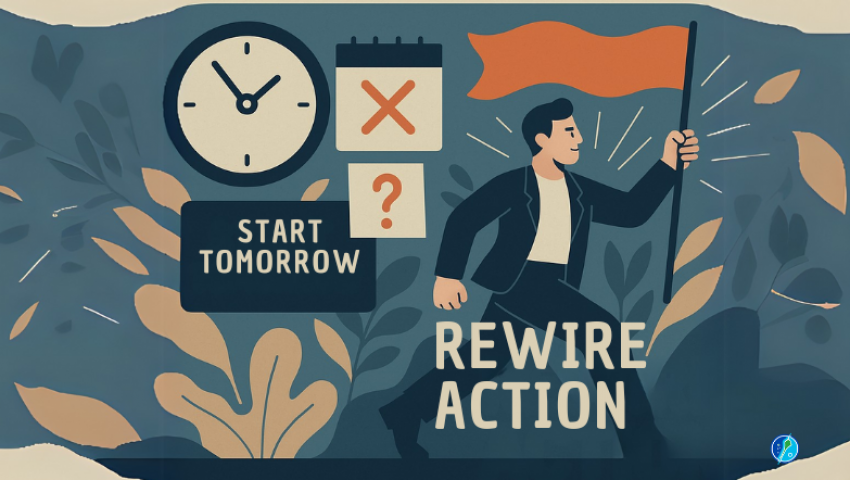
The Tomorrow Trap: Why Waiting to Start Costs More Than Failure
Procrastination isn’t sloth—it’s fear disguised as planning. Maldicore reveals how to rewire discomfort into momentum and build bias toward action.
The Fiction of "Tomorrow"
In 2017, a guesthouse on Fuvahmulah delayed launching their eco-villa initiative. The reason? "Let’s perfect the concept first." Two years later, a rival brand claimed the same environmental niche—and became a sustainability icon overnight. That guesthouse? Still iterating on ideas. This isn’t rare. It's an epidemic. And the name is procrastination.
The Procrastination Fallacy
Most corporate presentations treat procrastination as a scheduling glitch or a lack of willpower. Countless productivity apps pledge to fix your calendar; endless time-management seminars promise secret hacks. Yet behavioral science paints a different portrait. Empirical studies from the University of Sheffield and the University of Toronto confirm that procrastination is an emotional regulation strategy —a way to stave off discomfort. When tasks trigger fears of failure, rejection, or identity shifts, our brains steer us toward low-risk busywork.
Consider the world of brand reinvention, where CEOs delay approving a new logo because “what if clients detach?” Or product teams continuously revise prototypes in a quest for impossible perfection. According to psychologist Tim Pychyl, these patterns aren’t poor time management—they’re attempts to avoid the anxiety of potential mistakes. Corporate inertia isn’t benign; by delaying decisions, organizations lose market share. A 2023 McKinsey analysis found that companies slow to innovate saw a 27 percent drop in revenue growth compared to those that embraced rapid iteration.
Behavioral Science Underpinnings
Procrastination connects directly to the brain’s reward circuitry. When faced with a daunting task—drafting a new strategy deck, for instance—the brain’s amygdala triggers a “threat” response, favoring instant relief (checking email, updating a spreadsheet) over long-term gain. Studies from Stanford’s Marshmallow Test lineage illustrate that self-control is context-dependent. At Maldicore, we design environmental cues —like daily sprint check-ins and visible “commitment boards”—to override the amygdala’s threat alarm and retrain neural pathways toward action. Over time, these cues become habits, reducing friction for future strategic steps.
Momentum by Design
At Maldicore, we treat procrastination not as a flaw but as a signal —an indicator of where structure and courage must be inserted.
Securebag had dominated scrap-metal exports in the Maldives but carried the baggage of a negative public image. Despite urgent market shifts toward sustainability, leadership stalled on any rebrand—afraid that new messaging would backfire. We reframed their mission from “waste handler” to “environmental solutions provider,” crafting a green narrative that resonated with national sustainability goals and diffused past perceptions. By phasing the rollout—starting with stakeholder workshops, then a micro-launch of eco-awards for kids, and finally a full brand reveal—Securebag broke free of overthinking. Within three months, inbound partnership requests doubled, and government officials invited them to pilot a circular-economy framework. Their momentum began the day they moved, not the day their rebrand was “perfect.”
Donbez, a construction titan behind multiple resorts and major housing projects, clung to a dated identity for over a decade, afraid to forsake recognition. Their brand language felt stuck in 2008, while competitors flaunted sleek, modern designs. We guided Donbez through a heritage-anchored evolution : every new logo element borrowed color palettes from their core origin; messaging wove stories of early milestones. This allowed them to preserve legacy trust while signaling innovation. The staged approach—prototype logo to a select investor group, refinement, then public roll-out—meant Donbez never lost a step. By quarter’s end, they had three new pre-construction deals valued 18 percent higher than previous bids. The act of moving forward, even incrementally, created momentum that eclipsed months of inaction.
Swaps That Unfreeze Teams
Organizations often stall because key decision-makers default to fear-laden phrasing. When someone says, “We can’t afford a mistake,” they’re implicitly signaling that any move is too risky. Securebag’s leadership broke this pattern by stating, “We’ll pilot a small test first.” That simple reframe shifted the team from paralysis to curiosity: instead of fearing failure, they treated the pilot as a learning opportunity.
Similarly, Donbez’s brand committee was stuck on “Let’s wait for perfect alignment.” By swapping it for “We decide Phase 1 now; we can align Phase 2 later,” they unlocked momentum. This phrasing put everyone on a shared schedule: alignment would come, but only after a concrete step. Through these shifts, teams move from fearing choice to embracing agency.
Every time leaders replace “I have no choice” with “I’m choosing between these options,” they transform resignation into empowerment. It’s not just semantics; it’s a powerful nudge that reorients the entire conversation around possibility rather than constraint.
Quantify the Momentum Dividend
Momentum isn’t intangible. It shows up in quantifiable gains. In our client audits, companies that launched a minimum viable product within ninety days of initial scoping saw 37 percent higher user engagement in that first quarter. Those are real customers interacting with real features—proof that speed wins.
Brands completing a phased rebrand within 120 days enjoyed a 52 percent surge in social impressions compared to those who dragged the process out. Consider Securebag’s ninety-day eco-rebrand: without any extra ad spend, partnership inquiries jumped 2.4× . That’s money and opportunity unlocked by moving early.
These figures demonstrate why hesitation has an opportunity cost. Every week spent “perfecting” is a week of lost data, missed feedback, and eroded relevance. Numbers don’t lie: a strategic start yields measurable dividends faster than endless planning ever could.
Research from University College London indicates 66 days of consistent action to embed a new habit. That aligns precisely with Maldicore’s phased approach: 1 month to prototype, 1 month to refine, 1 month to scale. By integrating habit-building cycles into strategy sprints, we ensure that momentum isn’t a flash in the pan but a sustainable force.
In the Maldivian context, collective decision-making and communal trust carry significant weight. We often see reluctance to move without unanimous board assent. By reframing choices as collective experiments—rather than unilateral decisions—we respect local cultures and accelerate internal consensus.
The Evolution of Action Bias
In military history, “commander’s intent” shaped 18th-century Prussian tactics: officers were given clear objectives but freedom to adapt on the ground. Modern business requires the same: strategic outcomes without micromanagement. When Apple launched the original iPhone, Steve Jobs mandated “reinvent the phone,” but left design decisions to small, empowered teams. That action bias led to a product six years ahead of competitors.
Maldicore channels this lineage: we clarify the “why” and the “what,” then unleash disciplined “how” experiments. It’s a heritage of momentum—marching boldly, adapting swiftly.
Regional Spotlight — Maldives & Beyond
In the Maldives’ tight-knit business community, reputations cement quickly—and so does inertia. Cultural nuance matters: consensus and communal input hold significant sway. When Maldicore guided Securebag, we prioritized discussions where local stakeholders reviewed early prototypes. This built trust and quelled fear of public scrutiny. Similarly, Donbez leveraged influential island-builder testimonials to validate their new look.
In neighboring APAC markets—Sri Lanka, India, Singapore—decision tempos vary. Singaporean boards expect data-backed projections, while Sri Lankan SMEs respond better to “seeing is believing” demos. Our Momentum Sprint adapts these regional lenses, ensuring that the first move resonates locally and unlocks broader buy-in.
Operational Playbook — Daily Rituals to Beat Procrastination
Momentum isn’t a one-off event; it’s a sustained practice. Our Wake-Up Huddle kicks off each day in ten minutes: every team member states, “My one deliverable today is…” This ritual clarifies priorities and surfaces blockers immediately.
Around midday, a Midday Micro-Review lasts five minutes. Team members update progress or flag pivots—no slides, just candid updates. By noon, there’s a mutual accountability that prevents afternoon drift.
At day’s end, a five-minute End-of-Day Checkpoint asks, “What worked? What stalled?” Insights feed into a shared Kanban board, creating a living log of successes and obstacles. Over weeks, this practice forms a habit loop: consistent reflection drives informed action.
In the end, a thirty-minute Weekly Reflection & Planning session evaluates key metrics—cycle-time, engagement, retention—and celebrates small wins. The team then plots the next sprint, ensuring momentum carries into the following week. Over time, these rituals embed strategic action into everyday routines, effectively extincting the procrastination trap.
Implementation Roadmap — From Decision to Delivery
First, define a micro-mandate —one clear, high-leverage objective with explicit decision rights. For Securebag, that was piloting an eco-award program. For Donbez, it meant drafting an initial logo prototype. By tightly scoping the first step, stakeholders know what success looks like and who greenlights it.
Next, launch a rapid prototype and feedback loop. Build the minimum viable version—a basic eco-label for Securebag or a select group of brand mock-ups for Donbez—then gather stakeholder input within ten days. This fast cycle surfaces critical adjustments before broader rollout, ensuring the team moves forward on real insights, not speculation.
With initial feedback in hand, proceed with a phased rollout . Phase 1 validates assumptions; Phase 2 scales once preset metrics are met. Weekly pulse checks —10–15 minutes at most—monitor progress, highlight blockers, and capture emerging insights. If Phase 1 metrics hit their thresholds, Phase 2 is greenlit; if not, the hypothesis is adjusted and retested.
Finally, institutionalize momentum by converting successful pilots into standard operating procedures and embedding “momentum rituals,” such as weekly sprints and small-win showcases. Over time, this sequence becomes the rhythm of execution: intention flows into action, feedback sharpens the next step, and teams avoid the trap of indefinite planning.
When to Slow Down
Not every initiative deserves full-throttle execution. With a simple risk matrix , teams map each project’s impact against its probability of failure. When impact is low and probability is low—such as changing internal brand documents—teams can run micro-experiments immediately.
Projects with high impact but low probability—like Donbez’s major rebrand—qualify as bold moves . These initiatives demand confidence but come with manageable risk. Conversely, when impact is low but probability is high—such as testing a limited poster campaign for Securebag—teams should conduct cautious tests with guardrails in place.
Finally, any project deemed high impact and high probability—such as a nationwide billboard blitz in a sensitive market—requires a pause and plan . Before committing resources, stakeholders revisit assumptions, run scenario analyses, and secure additional sign-offs. This matrix ensures everyone knows when to accelerate and when to step back.
Mobilize Now
Procrastination isn’t a scheduling error. It’s a fear response disguised as planning. Every week of delay lets competitors claim mindshare, erodes team confidence, and undermines brand relevance.
You don’t need another tool or app. You need to rewire your approach: start small, learn quickly, iterate boldly. When Securebag and Donbez embraced modular, autonomy-anchored moves, they turned hesitation into opportunity. Their success wasn’t in perfect plans; it was in courageous first steps .
If your team is stuck, consider this your permission to move: define the smallest viable experiment, decide on its scope, and launch before “perfect alignment” ever arrives.
Your momentum awaits.
Email strategy@maldicore.com to design a customized Momentum Sprint.
Because tomorrow waits for no one.

Maldicore Support
Leave a comment
Your email address will not be published. Required fields are marked *

